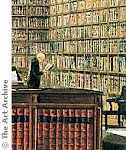One of the popular methods of preserving books that are in a state of deterioration, or brittle books, is to transfer the content to microfilm. However, with the onset of digital preservation this method has fallen out of favor with the National Endowment for the Humanities (NEH). NEH has been the driving force behind a 20-year program of transferring three million brittle books to microfilm. However, with significant budget cuts the NEH has pulled funding from this project, known as the Brittle Books Program, reducing it from $12-million in 1989 to less than $3-million in 2001 (Marcum, 2002). Research into the root causes for deterioration have yielded methods of delaying that deterioration; these methods have been enacted by many libraries lessening the librarians concern over preservation of the materials. This reduction in concern coupled with the reduction in funding means the goal of the Brittle Books Program may not be reached by 2009. It is human nature to procrastinate when there is a long road ahead. However, we are hiding our heads in the sand by assuming de-acidification techniques and improved storage techniques will fix the problem. Books are fragile and their content must be preserved.
Now on to an interesting twist in Marcum's article (Marcum, 2002). As just stated, books are fragile. However, if you look at the dependency of digital media on specific technology you find digital media may be even more fragile than the printed sources. Marcum argues that microfilming is still the best method of preserving information because microfilm readers are simple, easily manufactured and are currently in use. Other forms of digital media may be dependent on specific software or hardware that is already in line for obsolescence. Whereas this issue has been analyzed as part of the preparation and implementation of the NDIIPP program, it is still an interesting arguement.
Marcum then switches gears by saying that even though microfilming should be the preferred method of preservation access to the preserved material is critical and digital forms are the best in that category. This can be a little confusing until you get to the heart of the article which seems to be a call for duplicate preservation, microfilming for long-term and digital for access. In addition, there are programs such as the Digital Library of Freedom that are working to provide a centralized location for the digital materials. This would prevent the cases of several libraries all preserving the same materials.
I can see the benefits of preserving material in multiple forms - something like saving your research paper on a thumbnail drive and printing out a hard copy. However, in times when funding has dried up significantly for these types of projects I do not see this as a logical approach. The most cost effective, efficient, and durable method must be decided upon along with standards for preservation so materials are preserved in a consistent manner. Libraries must continue to prolong the life of books by improved handling and storage. Microfilming of volumes specific to the individual library would also be prudent. But for the multitudes of volumes that are common to many libraries, digitization should be tackled by the programs that have the funding and the project planning to successfully accomplish the task.
Reference
Marcum, D., & Kenney, A. (2002, March 8). The preservation of our brittle books must also preserve access. The Chronicle of Higher Education, 48(26), B20.
Monday, April 14, 2008
Preservation Microfilming versus Digital
Labels:
Preservation Microfilming
Subscribe to:
Post Comments (Atom)

3 comments:
A former instructor made the exact same point as "Other forms of digital media may be dependent on specific software or hardware that is already in line for obsolescence." I think I would be terrified to be an archivist in this day and age, with all the formats and mediums changing so rapidly.
I agree with you Amy. Every time you look around something new is replacing the things that we have already gotten use to.
Tamu
Preserving information in microfilm and digitally maybe the only way. Do you need a special machine to read microfilm? Digital can be transferred faster. I came into library work after computers were used for OPACs. I have never even seen a microfilm.
Post a Comment